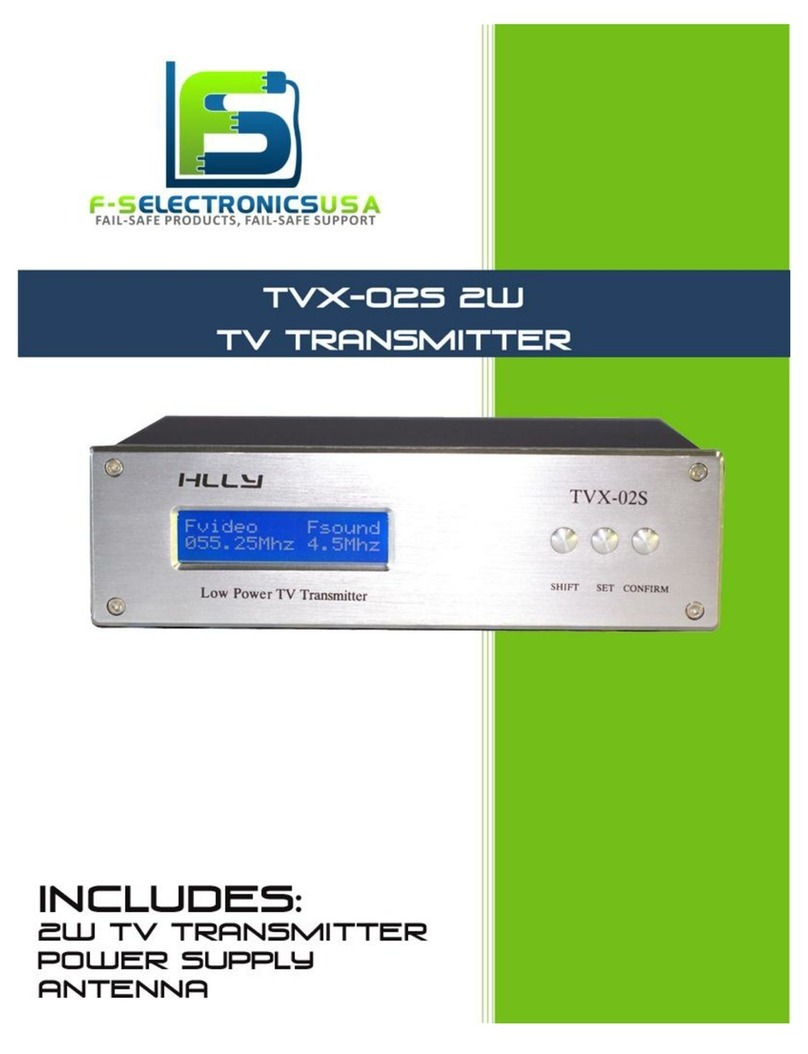F-S Electronics 2016© 3
Tips & Tricks:
1. Antenna: Always operate the transmitter with a suitable antenna or 50 Ohm dummy load to the output. Failure to comply may cause serious
danger or destruction to the output stage of the transmitter and void warranty coverage.
2.Power Supply: Do not exceed 12V 6A power supply. For best results use a Fail-Safe supplied power supply.
3.MIC: Do not use a MONO plug-type microphone, doing so may cause permanent damage and void warranty coverage.
4.Sound: When using most FM transmitters with a PC or MAC computer the volume level will need to be optimized at devices: (1) transmitter
(2) computer sound card, (3) Media player software, and (4) FM receiver radio. If necessary, you may consult the instructions of the audio
device to toggle the Equalizer. If Bass is distorted, or static is heard, minimize bass levels in the input device.
Troubleshooting:
1. Distortion/Static: Make sure to set the volume level of audio source deviceand the transmitter at MOST at the 50% and adjust up from
there. When using transmitter with PCs or devices with Bass Boost or higher bass settings, you will want to minimize the levels for the
transmitter does have a built in pre-amp which further amplify the bass and it will be broadcast as static or crackle. Also note that this
transmitter’s sound output level will not match local radio station’s volume levels.
2. Transmit range is weak: The transmit range will vary as per your environment, antenna type, power setting, and/or frequency setting. You
may need to upgrade the antenna. Placing the antenna on the highest altitude inside or outside of a building with the least amount of obstacles
will give you the optimum range. Please note that the average broadcast range with the stock rubber duck antenna is around 300 feet to a
vehicle stereo. Receiver units with weaker strength antennas, may not get even half of this range. For best results, check out our other
antennas, transmitters, or contact us.
3. Constant hum on radio/when broadcasting: Most likely cause is the audio cable or MIC but it can also be the power supply, input device,
or antenna. HUM IS RARELY CAUSED BY THE ACTUAL TRANSMITTER!
Proceed with the following steps to attempt correcting the hum:
1) To attempt to correct please start by assuring all cables are isolated from all power sources and that nothing is coming in contact with the
Antenna or Antenna port.
2) If the hum persists, remove the audio cable and MIC from the transmitter so that all that is connected to the transmitter is the power
supply and antenna.
3) If the hum ceases, it is either a bad audio cable, the audio cable is resting on another wire that is causing the hum, or the input device is
causing the hum.You may also have to separate your transmitter from your input device. We do have Audio Cables in lengths up to 100 ft.
Also, use of input devices with battery chargers has been known to cause issues with hum/feedback.
4) If the hum persists ensure the antenna pieces are snug. In addition the antenna should remain in an 90° position. If it easily tips over,
the antenna may be the issue.
5) If hum persists, the only thing left is the power supply. Contact us if through this troubleshooting leads you to believe that it is the power
supply or antenna.
4. Transmitter will not power on: Please test with either another 12 V power supply briefly with the transmitter. If you do not have another
power supply, try the transmitter power supply with another device that accepts 12 V of power, or test it to see if it is still functional. If you find
that the power supply is the issue, or if you do not have the means to test it, please contact us and we can make arrangements.
5. Transmitter powers on, but not transmitting: Please ensure the is not displayed to the right of the frequency. If it is, please refer to the
Power Adjustment Menu Instructions. If it does not transmit still and the is not displayed, then please contact us.
DISCLAIMER: Transmitter has the ability to adjust power output to levels that may cause the transmission to exceed the
FCC allowed use of the device. It is the customer’s responsibility to be familiar with FCC regulations, and to ensure that
the transmitter is set to the proper levels allowed within the FCC rules part 15. Licensing of wireless broadcast
transmissions, including for amateurs, through the FCC can be found at the following web address online:
wireless.FCC.gov






















